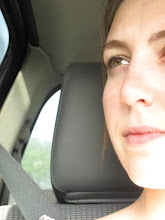Car seats are one of those baby items that you absolutely can not do without. And like every parent, I wanted to keep my little ones as safe as possible. I quickly became passionate about car seat safety while researching for a replacement for Pauly's infant carrier. At the time I knew nothing about convertible car seats which led me to countless hours of on-line learning. I can't remember exactly when I stumbled upon extended rear facing but, I do remember wondering why I'd never heard of it before. I had been certain that Pauly's first birthday would mark the milestone where he would ride facing forward but I quickly decided against it. Here's why:
Keeping children rear facing passed the recommended 20lbs. and one year of age keeps them five times safer then when they are forward facing. FIVE TIMES SAFER! I couldn't believe it at first. Then I went digging even further and found that the American Academy of Pediratics published a new policy in March of 2011 that recommends children be rear facing until the age of two or even longer, if they are still within the weight and height of the seat. I started wondering why it was only a recommendation and not part of the child seat laws. Then came the question of "what exactly are they testing for and how are they doing it?". I was a little surprised at what I found but you can read about Transport Canada's rear facing infant seat testing and research here.
Now, how exactly does a rear facing seat keep a child safer? Physics.
Newton's first law of motion states that "An object in motion continues in motion with the same speed and in the same direction unless acted upon by an external force". This external force is what causes the occupants to be thrown towards the front of the vehicle in a head-on collision.
When a child is rear facing, he will move towards the back of the seat and gently slide up. This keeps the child's head, neck and spine in a straight line and lets the chair absorb most of the force.
In a forward facing seat, the child (or adult) is held in place by the safety belt but the head whips forward until it touches the chin then back again. As an adult you can endure this whiplash motion because the weight of your head is only 6% of your body mass. A child's head is 25% of it's body mass which means it will pull away from the body with a force 4 times greater than that of an adults. Science has shown that even though a childs' spinal colum can stretch up to 2 inches, the spinal cord will only stretch a 1/4 of an inch, causing it to snap. This violent movement could internally decapitate a child leaving them paralyzed.
This video will help put things a little more into perspective.
If you'd still like to read more about car seat safety, here's a great article I found on parenting.com
So, armed with the above information, I set out to buy a car seat that would allow me to rear face as long as possible. My choice was a Britax.
Since the 1970's they have been recognized as the top selling car seat in Europe, England and Australlia. Now in the USA, Britax has been the top rated car seat for safety, durability and reliability. Enough said...but I still had to know more. So if you would also like to know about Britax's integrated steel bars, SafeCell Technology, Versa Tether or other features that make this seat an awesome choice, you can read about it here.
Riley is now 9 months old, but most importantly, she is reaching the 22 lbs. limit of her infant carrier. That means it's time for me to start putting some extra money aside so I can buy my absolute fave Britax seat. The only question is, do I buy it in pink?
Pumpkin Protein Muffins
4 days ago

